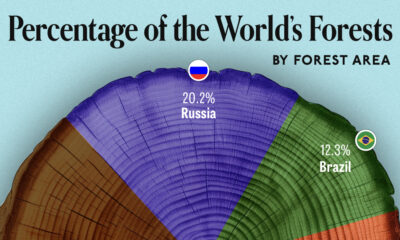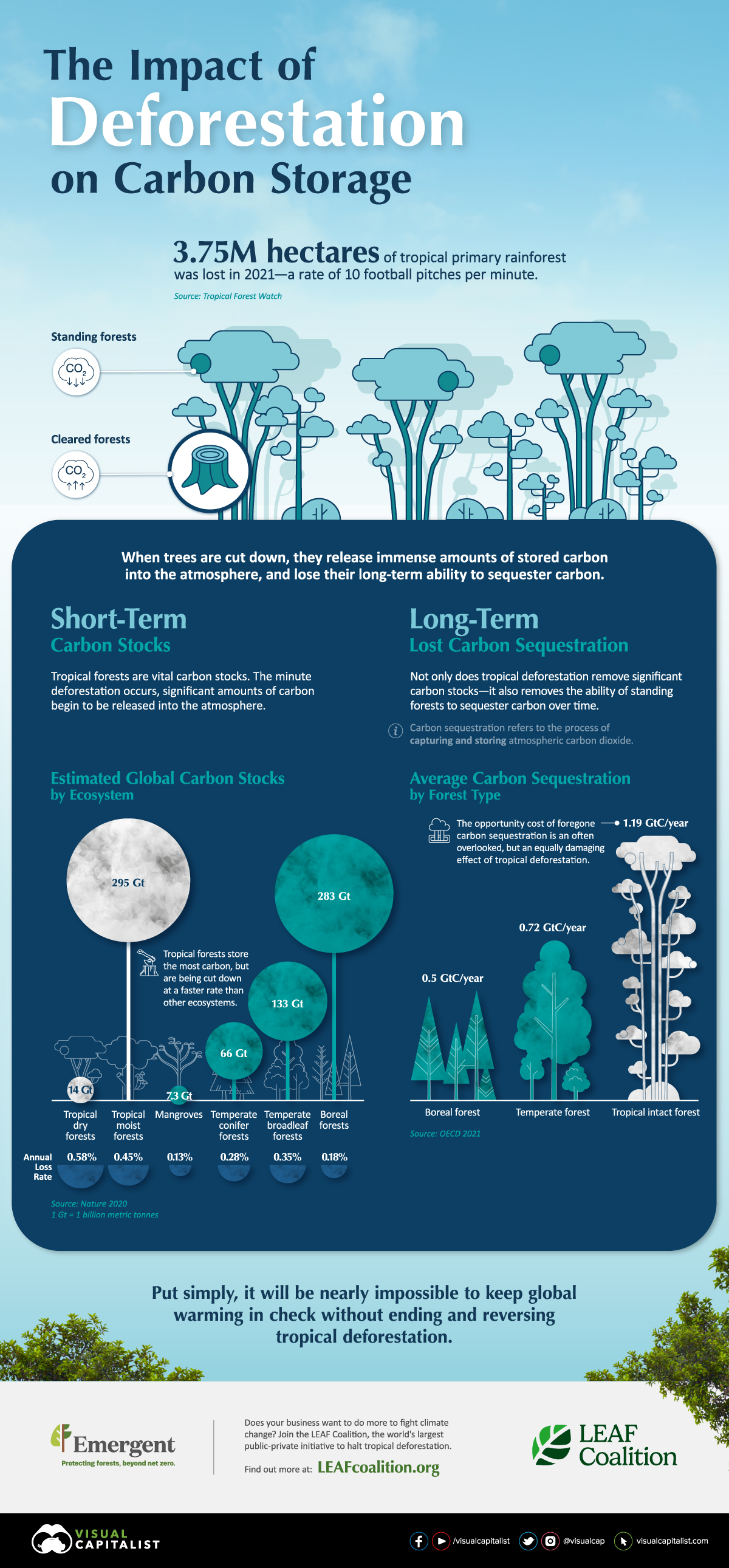The Impact of Deforestation on Carbon Storage
The Impact of Deforestation on Carbon Storage
A one degree change in temperature could have catastrophic consequences.
One of the most notable influences on rising global average temperatures comes from deforestation. In fact, combined emissions from deforestation are higher than the annual emissions of any other country (apart from the U.S. and China) and contribute to roughly 12% of total annual greenhouse gas emissions.
This graphic from The LEAF Coalition takes a closer look at the impact deforestation has on global greenhouse gas emissions through carbon storage.
The Short and Long-Term Impacts
The devastating impact deforestation has on the environment cannot be understated. By some estimates, 30% of the globe’s carbon emissions are absorbed by forests each year. Yet 3.75 million hectares of tropical primary rainforest were lost in 2021, equating to 10 football pitches per minute.
However, the problem deforestation poses is actually two-fold—carbon stocks in the short-term and carbon sequestration in the long-run.
Forests have powerful carbon stocking capabilities. This refers to their ability to store carbon in biomass like their roots, trunks, and branches. Here’s how global carbon stocking by ecosystems compare:
| Ecosystem | Estimated Carbon Stock (Gt) | Annual Loss Rate |
|---|---|---|
| Tropical moist forests | 295 Gt | 0.45% |
| Boreal forests | 283 Gt | 0.18% |
| Temperate broadleaf forests | 133 Gt | 0.35% |
| Temperate conifer forests | 66 Gt | 0.28% |
| Tropical dry forests | 14 Gt | 0.58% |
| Mangroves | 7.3Gt | 0.13% |
Once deforestation commences, all the carbon once stored begins to release into the atmosphere. This directly contributes to higher emissions.
Next, is carbon sequestration, which is the process in which carbon is removed from the atmosphere. Every year, forests capture and extract anywhere from 0.5 gigatonnes of carbon (GtC) for boreal forests to 1.19 GtC for tropical intact forests. Unfortunately, deforestation removes the ability for standing forests to sequester carbon entirely.
The Way Forward
The world lost more than 10 million hectares of primary tropical forest in 2021. This goes directly against the need to cut deforestation by 75% by 2030 in order to keep our global average temperatures at 1.5℃.
Here are some other facts on the deforestation that has occurred over the last three decades:a
- Latin America and Africa have had the highest levels of deforestation
- 43% of countries have seen a net reduction in their forest area
- Since 1990, the world has lost 4% of its forests—equivalent to 685k square miles
Swift action is required in order to slow deforestation and decelerate rising average temperatures. See how The LEAF Coalition, a public-private initiative is accelerating climate action by providing results-based finance to countries committed to protecting tropical forests.

-

 Green1 week ago
Green1 week agoRanking the Top 15 Countries by Carbon Tax Revenue
This graphic highlights France and Canada as the global leaders when it comes to generating carbon tax revenue.
-

 Green1 week ago
Green1 week agoRanked: The Countries With the Most Air Pollution in 2023
South Asian nations are the global hotspot for pollution. In this graphic, we rank the world’s most polluted countries according to IQAir.
-

 Environment2 weeks ago
Environment2 weeks agoTop Countries By Forest Growth Since 2001
One country is taking reforestation very seriously, registering more than 400,000 square km of forest growth in two decades.
-

 Green3 weeks ago
Green3 weeks agoRanked: Top Countries by Total Forest Loss Since 2001
The country with the most forest loss since 2001 lost as much forest cover as the next four countries combined.
-

 Markets2 months ago
Markets2 months agoThe World’s Top Cocoa Producing Countries
Here are the largest cocoa producing countries globally—from Côte d’Ivoire to Brazil—as cocoa prices hit record highs.
-

 Environment2 months ago
Environment2 months agoCharted: Share of World Forests by Country
We visualize which countries have the biggest share of world forests by area—and while country size plays a factor, so too, does the environment.



